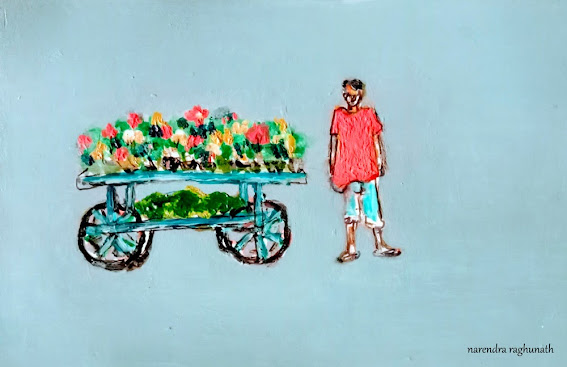Razak Bahi, poster colour on paper
My encounter with Razak Bhai took place in the Paanch Kua area of Ahmedabad back in 2003. I was a newcomer to the city, and was on a look out for a piece of thick canvas cloth. My search led me to his modest shop in Panch Kua. Paanch Kua boasted several canvas stores, but Razak Bhai's establishment was notably smaller. Contrasting with the typical exuberance of Gujarati salespeople, he briefly glanced up from his reading when I entered, then returned to his holy book. It was evident that he was engrossed in his reading. I perused his limited selection of canvas fabrics and asked him to cut a few meters for me. Without making eye contact, he promptly rose and cut the fabric. I paused to inquire about the price, and he gazed at my face for a moment before uttering, "Saat rupia bhai... kaatoon?"
This marked my introduction to Razak Bhai, and our friendship commenced, lasting for the next three years until 2006 when he departed from Ahmedabad, returning to his village near Surat. Our friendship didn't have its inception that very day; instead, it began on a Friday in the following weeks. I revisited his shop on a Friday afternoon after an interval of about two weeks. Despite the shop being open, Razak Bhai was nowhere in sight. I patiently waited for nearly half an hour, enjoying a coconut milkshake, a Paanch Kua specialty. When he returned after his Friday Namaz, I politely inquire about the security of his shop and the possibility of theft. For the first time, a smile graced his face as he asked, "Aap ne kyon nahi liay bhai? (Why didn't you take something then?)" I responded that I don't steal.
"Bhai, bhaakhi log aap ke tharah naheen hein kya?; aap kyon aise soch they hein? (Brother, everyone is like you only no; why don't you start thinking about others like that?)" he remarked.
I had no answer, and he continued, "Jho Allah thala apne nazeeb mein likha hein, woh hee hamare paas raheka. Jithna bhi tala dalo, baakhi sab woh apne se ley key hee raheka (What is written in one's destiny by the Almighty is what will remain with us. No matter how much you lock it away, everything else, He will take back from you)."
This exchange was a profound introduction to his philosophy, and it paved the way for a deep and enduring friendship between us.
Razak Bhai had been thriving before the 2002 riots, having a wonderful family and a thriving textile business. Tragically, the riots took away both his family and business. He had two children and a successful textile business. When the riots erupted, he happened to be in South India to collect payments. When he returned after two days of turmoil, he found that everything had been destroyed—his family and his business.
During this period, I was engaged in documenting the stories of the children affected by the riots, both the accused and the victims. I made numerous attempts to discuss the impact of the riots on his life, but he consistently deflected these questions with a recurring line: "Sab Allah ka marzi hein bhai, hum kon hota hein isab pooch ne keliye? (Everything is God's will, who am I to question it?)"
He was a deeply religious man, and despite his philosophical outlook and unwavering faith in his God, there was a pervasive air of sorrow about him. In 2006, as his makeshift shop structure was replaced by a new construction, he parted his ways from the town, returning to his village near Surat. Before departing, he gifted me a roll of canvas, which still remains unopened in my studio. Every time I contemplate opening it, Razak Bhai's smiling countenance comes to mind. As he used to say, "Allah thala ka Marzi", there must be something waiting to happen in that canvas, and its time is not yet come.













